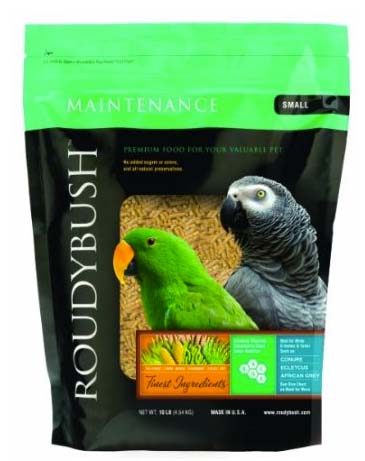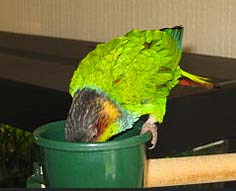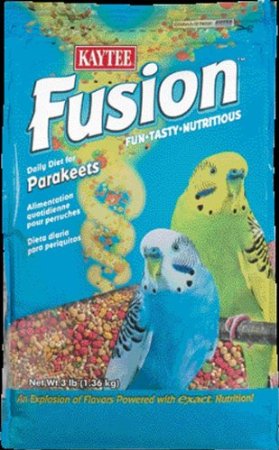Choosing a Parakeet Food and Diet
The parakeet food of choice used to be a seed mix with white millet seeds as the primary component. While Parakeets can survive on a white millet seed diet, today, we know that being restricted to only this diet will result in health problems. For example, researchers suspect that the high incidence of cancer in parakeets is related to a poor bird diet. The key to a healthy diet is making sure that a parakeet receives enough vitamin content in the food. This can be provided in a mix of pellets, fresh vegetables, fruits and a small amount of fortified seeds.

The Roudybush Daily Maintenance Specially Steam-pelleted Parakeet food contains 11-Percent protein and 7-Percent fat
Source: Amazon
Today, a parakeet diet should consist of 60% to 70% parakeet pellets, with the rest a combination of dark green leafy vegetables, fruits, and a small amount of fortified seeds.
Use a Small Parakeet Feed Cup
Seeds used to be the primary recommended food provided to parakeets. If you do feed your parakeet seeds, the best practice is provide a small feed cup that contains only 1 day worth of seeds. Each day uneaten seeds and shells should be discarded and replaced the next day with a new cup of seeds. This is a change from the past practice of providing a larger feed cup that contains enough seeds for several days. The problem with larger feed cups is that as the parakeet shells the seeds, they are left behind in the feed cup, making new feed less accessible to the bird. Since the cup will appear full to an owner, in reality the seed cup may be empty. If the cup is not continually refilled, it could result in starvation.

Blue-chested Parakeet (also called Pyrrhura cruentata, Blue-throated Parakeet, Blue-throated Conure) feeding from bowl
Source: Wikimedia/Redvers
Do not provide more parakeet food than can be eaten in a day.
Parakeet Pellets as an alternative Food to Seeds
Pellet parakeet diets are made in small sizes and provide the budgie with balanced nutrition. A popular brand is the Kaytee Exact Parakeet Diet that can be either a replacement for parakeet seed, or provided as a special treat. Another alternative is the Kaytee Fortified Seed Mix. Another option, Kaytee Fusion, mixes together parakeet food pellets and seed.

Kaytee Fusion Parakeet Food Mixes Together Food Pellets and Seed
Source: Amazon
To change from a seed to a pellet diet, changeover food gradually. Match the pellet intake to the amount of seeds each day. To get an accurate count, measure the amount of seed placed into the cage each day. Then measure the amount of parakeet seed left in the bowl. The difference over a week is the amount of seed eaten each day (don't bother measuring seed on bottom of cage). Match the amount of parakeet pellets to the amount of seed consumed daily.
If a parakeet will not switch or eat pellets, try sprinkling some seeds on a yam. Then replace the seeds with crushed pellets. To make sure your bird is eating, it isn't a bad idea to measure your parakeets weight to make sure that he or she is eating.
Recommended brands of Parakeet Pellets:
There are several high quality parakeet food pellets available on the market including:
- Roudybush
- Lafeber
- Mazuri
- Pretty Bird
- Kaytee
Fresh Parakeet Food
There are several fresh foods that can add required vitamins to the budgie diet. These include:
- Small portions of dark green leafy vegetables and sprouts
- Yams
- Carrots
- Squash
- Orange bell peppers (high in vitamin A)
- Fruit
- small apple slices
- grapes
- melon
- Boiled eggs or parakeet egg food (for parakeets that are breeding or that are young)
Do not allow the food to become contaminated in the cage. Remove before contamination can set in, which occurs in about 24 hours. To stay on the cautious side, remove fruits and vegetables a few hours after being in the cage.
When providing fruit, consider making it appealing by hanging it from the cage top or by weaving food into the parakeet cage bars.
Parakeet treats should not be more than 10% of the budgie diet.
Parakeet Vitamin Supplements
If you are only feeding your parakeet seeds, then a vitamin supplement should be added to the water if recommended by your veterinarian. Iodine in particular is critical to avoid the disease parakeet goiter. Note that most adult birds that are eating a healthy diet do not require supplements. Providing supplements in addition to a fortified diet could result in an overdose.Wash the water bottle daily to avoid bacteria buildup (whether using liquid parakeet supplements or not).
Parakeet Water Bottles
Fresh water should be provided every day. Check the tip of the bottle daily to ensure that nothing is blocking the tip. Make sure that baby parakeets know how to drink from the bottle. If a parakeet is not drinking, dehydration can occur in one to two days.Parakeet Grit
Some birds require grit to properly digest food. Parakeets do not require grit for digestion.
Parakeet Poisonous Foods
Do not feed your parakeet the following foods:
- chocolate
- avocado
- fruit seeds
- anything with caffeine
- anything with alcohol
- sugar
- high fat foods
Best Parakeet Feeding Time
In the wild, most birds eat at 1/2 hour after sunrise and a second time before sunset. Some parakeets will also enjoy eating vegetables and fruit at different times during the day. Some birds might prefer to eat frequently throughout the day. Do not provide more food than can be consumed in one day.
Related articles
Training
parakeets
Parakeet
toys
Parakeet
photos
Parakeet
health
Parakeet
illness symptoms
Adopt a bird
Parakeet
Eggs and Breeding
From Parakeet Food to More Information on Parakeet Care
To Cool Small Pets home page
Comments
Have your say about what you just read! Leave me a comment in the box below.